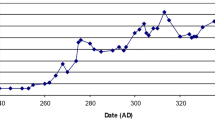Abstract
Roman Coinage suffered from severe debasement during the 3rd century AD. By 250 AD., the production of complex copper alloy (Cu-Sn-Pb-Ag) coins with a silvered surface, became common practice. The same method continued to be applied during the 4th century AD for the production of a new denomination introduced by Diocletian in 293/4 AD. Previous analyses of these coins did not solve key technological issues and in particular, the silvering process. The British Museum kindly allowed further research at Bradford to examine coins from Cope’s Archive in more detail, utilizing XRF, SEM-EDS metallography, LA-ICP-MS and EPMA. Metallographic and SEM examination of 128 coins, revealed that the silver layer was very difficult to trace because its thickness was a few microns and in some cases it was present under the corrosion layer. Results derived from the LA-ICP-MS and EPMA analyses have demonstrated, for the first time, the presence of Hg in the surface layers of these coins. A review of ancient sources and historic literature indicated possible methods which might have been used for the production of the plating. A programme of plating experiments was undertaken to examine a number of variables in the process, such as amalgam preparation, and heating cycles. Results from the experimental work are presented.
Similar content being viewed by others
References
R.A.G. Carson, Coins of the Roman Empire,1st ed. (Routledge, London and NY, 1990).
K. W. Harl, Coinage in the Roman Economy, 300 B.C. to A.D. 700 (The Johns Hopkins University Press, Baltimore and London, 1996).
C. Vlachou, R.C. Janaway and J.G. McDonnell “The metallurgical investigation of the tetrarchic nummi,” (cd-rom Archaeometry 2000, Mexico City).
C. Vlachou, G. McDonnell, R. Janawayet al., “Silver plating in Late Roman Coinage: Implications of New Evidence,” presented at the Archaeological Science 2001, Newcastle, 2001 (unpublished).
L.H. Cope “Surface-Silvered Ancient Coins,” in Methods of chemical and metallurgical investigation of ancient coinage, edited by E.T. Hall and D.M. Metcalf (Royal Numismatic Society, London, 1972), pp. 261–278.
L. H. Cope, The metallurgical development of the Roman Imperial Coinage During the first five centuries AD. (PhD Thesis, Liverpool Polytechnic, (1974).
L.H. Cope “The argentiferus Bronze Alloys of the large Tetrarchic Folles of A.D. 294-307,” Numismatic Chronicle viii, 115–149 (1968).
K. Anheuser and J.P. Northover “Silver plating on Roman and Celtic coins from Britain - a technical study,” The British Numismatic Journal 64, 22–32 (1994).
S. La Niece, “Silvering,” in Metal plating and patination: cultural, technical and historical developments, edited by S. La Niece and P. Craddock (Butterworth-Heinemann, Oxford, 1993), pp. 201–210.
K. Anheuser, “Where is all the amalgam silvering?,” in Materials Issues in Art and Archaeology V, edited by P. Vandiver, J.R. Druzik J.F. Merkel et al. (Materials Research Society, Massachusetts, USA, 1997), Vol. 462, pp. 127–134.
H. Lechtman, “A pre-Columbian technique for electrochemical replacement plating of gold and silver on copper objects,” Journal of Metals 31, 154–160 (1979).
W.A. Oddy “A history of gilding with particular reference to statuary,” in Gilded Metals. History, Technology and Conservation, edited by T. Draymann-Weisser (Archetype Publications Ltd., London, 2000), pp. 1–20.
Theophilus, On divers arts: the treatise of Theophilus (The University of Chicago Press, (1963).
V. Biringuccio, The Pirotechnica of Vannoccio Biringuccio. (American Institute of Mining and Metallurgical Engineers, New York, (1959).
M. Berthelot, Collection des anciens alchimistes Grecs (Georges Steinheil, Paris, 1888) Recipe No25 pp. 328.
S. La Niece, “Technology of silver plated coin forgeries,” in Metallurgy in Numismatics, edited by M Archibald and M. Cowell (Royal Numismatic Society Special publication, London, 1993), Vol. III, pp. 227–236.
K. Eremin and N. Holmes, “Counterfeiting of 16th century Scottish coins,” presented at the Counterfeiting- ancient and modern, London, 2000 (unpublished).
C. Vlachou, G. McDonnell, and R. Janaway, “New evidence for the process used to silver plate counterfeit dirhams,” Numismatic Chronicle (2002) (in press).
A.H. Morton “An Iranian Hoard of Forged Dirhams,” Numismatic Chronicle 15, 155–168 (1975).
K. Anheuser, “An investigation of amalgam gilding and silvering on metalwork,” PhD., Oxford University, 1996.
Benvenuto Cellini, “The treatises of Benvenuto Cellini on goldsmithing and sculpture,” (Dover Publications, New York, (1967).
C.S. Smith and J.G. Hawthorne Mappae Clavicula (The American Philosophical Society, Philadelphia, (1974).
P. T. Craddock, “The composition of the copper alloys used by the Greek, Etruscan and Roman civilisations. 2. The archaic, classical and hellenistic greeks.,” Journal of Archaeological Science 4, 103–123 (1977).
W.A. Oddy M.R. Cowell P.T. Craddock et al., “The gilding of bronze sculpture in the classical world.,” in Small Sculpture from the Ancient World., edited by M. True and J. Podany (Getty Museum, Malibu, 1990), pp. 103–124.
P. Jett, “A study of the gilding of Chinese Buddhist bronzes,” in Metal plating and patination: cultural, technical and historical developments, edited by S. La Niece and P. Craddock (Butterworth-Heinemann, Oxford, 1993), pp. 193–200.
P. Jett and W. T. Chase, “The gilding of metals in China,” in Gilded Metals. History, Technology and Conservation, edited by T. Draymann-Weisser (Archetype Publications Ltd., London, 2000), pp. 145–156.
Author information
Authors and Affiliations
Rights and permissions
About this article
Cite this article
Vlachou, C., McDonnell, J.G. & Janaway, R.C. Experimental investigation of silvering in late Roman coinage. MRS Online Proceedings Library 712, 92 (2001). https://doi.org/10.1557/PROC-712-II9.2
Published:
DOI: https://doi.org/10.1557/PROC-712-II9.2




